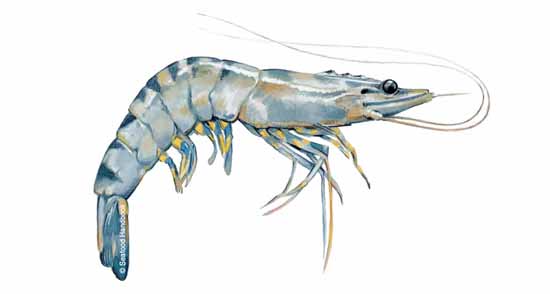Shrimp, Black Tiger
Published on
January 23, 2014

Striped like its jungle namesake, the black tiger shrimp is available year-round and is one of Asia’s major aquaculture products. Most tiger shrimp is farmed, though a significant amount is harvested from the wild by trawlers working mud bottoms from very shallow water to depths beyond 300 feet. The largest of 300 commercially available shrimp species worldwide, tigers can grow to 13 inches, but harvest size averages 9 to 11 inches. Many countries supply black tigers from both farmed and wild sources. The species is distributed over a huge range, from east and southeast Africa through the Red Sea and Arabian Gulf, around the Indian subcontinent and through the Malay Archipelago to northern Australia and the Philippines. Important suppliers include Thailand, Bangladesh, India, Indonesia and Malaysia. Asian suppliers generally offer state-of-the-art packing and processing; many follow HACCP guidelines developed for U.S. operations.
Penaeus monodon
Shrimp
Black tiger, giant tiger, jumbo tiger shrimp
Crevette
Garnele
Gambero
Ebi
Camarón
Striped like its jungle namesake, the black tiger shrimp is available year-round and is one of Asia’s major aquaculture products. Most tiger shrimp is farmed, though a significant amount is harvested from the wild by trawlers working mud bottoms from very shallow water to depths beyond 300 feet. The largest of 300 commercially available shrimp species worldwide, tigers can grow to 13 inches, but harvest size averages 9 to 11 inches. Many countries supply black tigers from both farmed and wild sources. The species is distributed over a huge range, from east and southeast Africa through the Red Sea and Arabian Gulf, around the Indian subcontinent and through the Malay Archipelago to northern Australia and the Philippines. Important suppliers include Thailand, Bangladesh, India, Indonesia and Malaysia. Asian suppliers generally offer state-of-the-art packing and processing; many follow HACCP guidelines developed for U.S. operations.
Farmed black tiger shrimp have a mild, almost bland flavor compared to the pronounced taste of ocean-harvested Gulf shrimp. Cooked tiger’s meat is also softer than that of other shrimp species. Tigers have gray to black stripes on gray or bluish shells and associated stripes on the peeled meat. The cooked shell turns bright red. The white flesh is tinged with orange if cooked peeled and red if cooked in the shell.Meat should be slightly resilient and moist. Improper storage temperatures, refreezing or extended frozen storage can turn shrimp tough, dry and fibrous. A black spot on the shell indicates melanosis. It’s not a health issue in early stages but indicates general poor quality.
| Calories: | 106 |
| Fat Calories: | 15.3 |
| Total Fat: | 1.7 g |
| Saturated Fat: | 0.3 g |
| Cholesterol: | 152 mg |
| Sodium: | 148 mg |
| Protein: | 20.3 g |
| Omega 3: | 0.53 g |
Large tiger shrimp tails are excellent hors d’oeuvres in classic shrimp cocktails or grilled on skewers. They’re good with pasta or in casseroles, since they can withstand tossing with other ingredients. Their thick shells hold heat, so black tigers cook more quickly than the other Penaeids. Watch them closely; they toughen if overcooked. For maximum quality, eat tiger shrimp within two days of thawing, though they will last three to four days properly refrigerated.
Lobster tails, Crawfish, Other Penaeid shrimp
- Bake
- Boil
- Broil
- Fry
- Grill
- Pate
- Poach
- Saute
- Smoke
- Steam
Frozen: Whole, Blocks, IQF, Split, butterfly, fantail, Pieces
Value-added: Breaded, Canned (small shrimp), Dried, Entrées
Bangladesh, India, Indonesia, Madagascar, Malaysia, Philippines, Taiwan, Thailand, Vietnam





